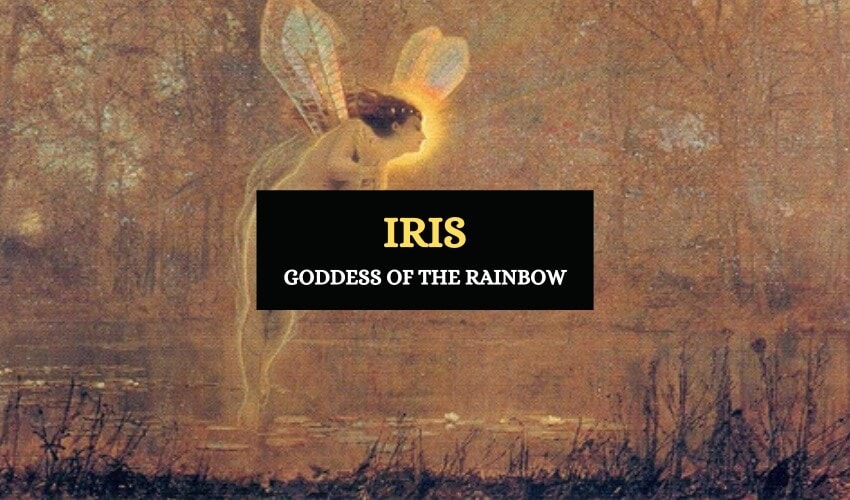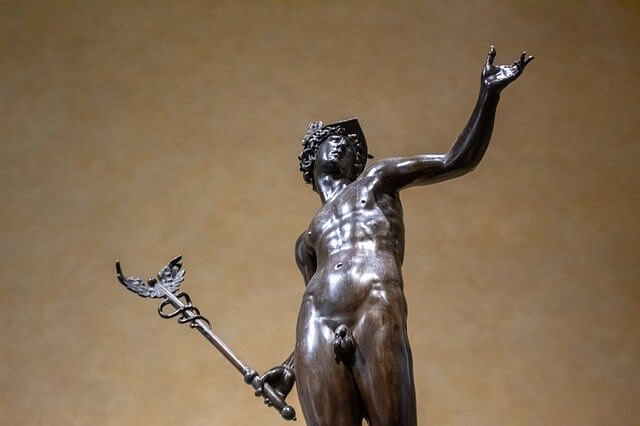
Table of Contents
In Greek mythology, Iris was the goddess of the rainbow and was also known as one of the goddesses of the sky and sea. She was a messenger of the Olympian gods as mentioned in Homer’s Iliad. Iris was a soft-spoken and cheerful goddess who also had the role of linking the gods to humanity. In addition, she served nectar to the Olympian deities to drink and was later replaced by the new messenger of the gods, Hermes.
Iris’ Origins
Iris was the daughter of Thaumas, a sea god, and the Oceanid, Electra. The parentage meant that she had some famous siblings, like the Harpies Ocypete, Aello and Celaeno who had the same parents. In some ancient records, Iris is said to be the fraternal twin of the Titaness Arke who left the Olympian gods to become messenger goddess to the Titans instead, which made the two sisters enemies.
Iris was married to Zephyrus, the god of the west wind and the couple had a son, a minor god called Pothos but according to some sources, their son was called Eros.
Iris As the Messenger Goddess

Apart from being the messenger goddess, Iris had the duty of bringing water from the River Styx whenever the gods had a solemn oath to take. Any god who drank the water and lied would lose their voice (or consciousness as mentioned in some accounts) for up to seven years.
Rainbows were Iris’ mode of transport. Whenever there was a rainbow in the sky it was a sign of her movement and a link between earth and heaven. Iris was often depicted with golden wings that gave her the ability to fly to every area of the cosmos, so she could travel to the bottom of the deepest seas and even to the depths of the Underworld much quicker than any other deity. Like Hermes, also a messenger god, Iris carried a caduceus or a winged staff.
Iris in Greek Mythology
Iris appears in several Greek myths and was said to have been found during the Titanomachy, the war between the Titans and the Olympians. She was one of the first goddesses to ally herself to the Olympians Zeus, Hades and Poseidon. Her role in the Titanomachy was to act as a messenger between Zeus, the Hecatonchires and the Cyclopes.
Iris also appeared during the Trojan War and has been mentioned by Homer many times. Most notably, she would come to transport Aphrodite back to Olympus after the goddess had been severely wounded by Diomedes.
Iris also played a small part in the lives of other heroes in Greek mythology and was said to have been present when Heracles was cursed by the madness sent by the goddess Hera, which caused him to kill his entire family.
In the story of Jason and the Argonauts, the Argonauts were just about to rescue the blind seer, Phineus from the punishment by the Harpies when Iris appeared to Jason. She asked Jason not to harm the Harpies since they were her sisters and so the Boreads didn’t kill them but simply drove them off.
Iris and Hermes as Messegner Gods

Even though Hermes became the more famous of the two messenger deities it seems that in the earlier days Iris monopolized the function. In Homer’s Iliad, she is mentioned as the only one who relayed messages from Zeus (and once from Hera) to the other gods and mortals while Hermes was given the smaller role of guardian and guide.
Also according to Iliad, Zeus sent Iris to inform the Trojan King Priam of his decision concerning his son’s dead body, while Hermes was sent to merely guide Priam to Achilles unnoticed.
During this time, Iris performed several vital tasks like informing Menelaus of his wife Helen’s abduction and granting the prayers of Achilles. She also summoned the winds to light the funeral pyre of Achilles’ friend Patroclus.
However, in the Odyssey, Homer mentions Hermes as the divine messenger and Iris isn’t mentioned at all.
Depictions of Iris

Iris is typically represented as a beautiful young goddess with wings. In certain texts, Iris is depicted as wearing a colorful coat which she uses to create the rainbows she rides. It’s said that her wings were so bright and beautiful, she could light up the darkest cavern with them.
Iris’ symbols include:
- Rainbow – her chosen mode of transport
- Caduceus – a winged staff with two entwined snakes, often mistakenly used in place of Asclepius’ rod
- Pitcher – the container in which she carried the water from the River Styx
As a goddess, she’s associated with messages, communication and new endeavors but she was also said to have aided in fulfilling the prayers of humans. She did this either by bringing them to the attention of the other deities or fulfilling them herself.
Cult of Iris
There aren’t any known sanctuaries or temples to Iris and while she’s usually depicted on bas-reliefs and vases, very few sculptures of her have been created throughout history. Evidence suggests that Iris was the object of minor worship. It’s known that the Delians offered cakes made from wheat, dried figs and honey to the goddess.
Facts About Iris
Iris is the child of Thaumas and Electra.
Iris’ siblings include Arke, Aello, Ocypete and Celaeno.
Iris is married to Zephyrus, the west wind.
Iris’ symbols include the rainbow, caduceus and pitcher.
Iris’ home may be Mount Olympus.
Iris’ Roman equivalent is Arcus or Iris.
Iris is the messenger goddess of the Olympian gods. However, Hermes takes over her role later in the myths.
Wrapping Up
After Hermes came onto the scene, Iris began to lose her status as a messenger goddess. Today, there are very few people who know her name. She doesn’t have any significant myths of her own but she does appear in the myths of many others famous deities. However, in Greece, whenever there’s a rainbow in the sky, those who do know her say that the goddess is on the move, wearing her coat of colors and spanning the distance between the sea and the clouds.








